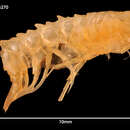Comprehensive Description
provided by Smithsonian Contributions to Zoology
Syrrhoe nodulosa K. H. Barnard
Syrrhoe nodulosa K. H. Barnard, 1932: 150–151, figure 88.
DIAGNOSIS.—Head not protuberant, lateral cephalic lobe sharp; eyes present; article 1 of antenna 1 keeled dorsally and with mediodistal tooth; article 2 lacking tooth; coxa 1 slightly expanded distally, coxa 2 evenly extended, posterior lobe of coxa 3 half total coxal height; gnathopodal palms with one serrate spine; article 2 of pereopod 5 expanded, angular, then weakly rounded ventrally, posterior teeth small; pereonite 7 and pleonites 1–3 each with 2 dorsal teeth in tandem, anterior member noduliform, posterior member bifid transversely, pleonites 1–4 and epimera 1–3 fully serrate posteriorly; uropod 3 scarcely exceeding uropods 1–2, peduncle elongate; telson elongate, cleft almost to base.
The elongate peduncle of uropod 3 is unusual in Syrrhoe.
Antarctic, tows between 160 and 500 m.
- bibliographic citation
- Barnard, J. L. 1972. "A review of the family Synopiidae (=Tironidae), mainly distributed in the deep sea (Crustacea: Amphipoda)." Smithsonian Contributions to Zoology. 1-94. https://doi.org/10.5479/si.00810282.124

